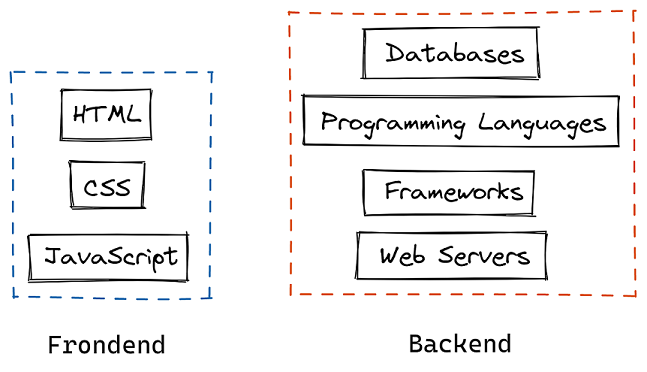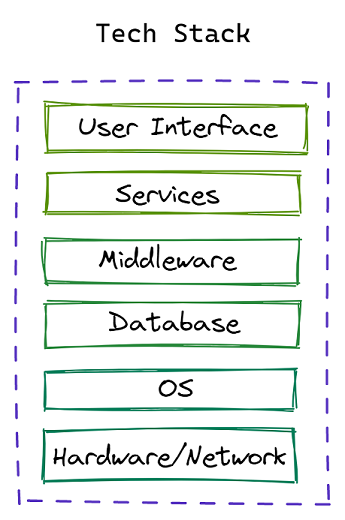Early on in the development of the web and mobile applications, there weren't many services, tools, or frameworks required to launch a website or application. The websites and applications were simple enough that creating and maintaining them was easy.
Now but things become a little more challenging because a single application frequently consists of numerous components that each require a different set of tools or programming languages.
Here, developers employ technology stacks to oversee each component of the application and ensure that everything functions as planned.
We will go over the following:
- What is Technology Stack?
- Components of the Technology Stack
- Technology Stack Models
- Benefits of Technology Stack
- Why is Technology Stack Important?
What is Technology Stack?
A set of tools, programming languages, and technologies collectively referred to as a "tech stack". It is used to create digital products or solutions like websites, mobile applications, and web applications.
Both the frontend (client-side) and backend (server-side) are crucial components of a tech stack. Both collaborate to build an effective tech stack. Another name for this is an application stack.
A tech stack is, to put it simply, a collection of software, programming languages, frameworks, and data storage tools that developers can use to create and run a single application. For example, Facebook's "tech stack" consists of JavaScript, HTML, CSS, PHP, and ReactJS among other frameworks and languages.
It might seem that developers might just take the first tool they discover to construct an application given the variety of programming languages, tools, and technologies available, but the process is far from simple.
Developers must consider the objectives, specifications, and needs of their project before choosing the tech stack that would work best for the application or website.
The tech stack utilized for a particular application can tell a lot about how that application is operating and what resources developers will need to make changes to or maintain it. Tech stacks are therefore especially helpful for hiring developers.

Components of the Technology Stack
The frontend and backend stacks are the two parts of a technology stack. The developer who creates the product's role is also influenced by these stacks.

Frontend Tech Stack
The client-side of the application is represented by the frontend tech stack. Anything that a user can view or interact with on a screen is referred to as client-side.
The frontend stack's primary goal is to develop a fantastic user experience, a smooth user interface, and simple internal structures. In other words, it is in charge of how websites and web applications are designed, formatted, and navigated.
The core components of a frontend stack are three which are:
- HTML (Hypertext Markup Language)
It is a markup language used to create and display electronic documents (web pages). They serve as the foundation for how content is arranged and placed on web pages. - CSS (Cascading Style Sheets)
It is in charge of the design and organization of the web pages. It comprises the layout, color, style, size, and other elements of a web page. Developers frequently employ CSS management and dynamic frameworks like SASS and LESS. - JavaScript
It is used to create interactive web pages. It's a programming language that lets you use well-known tools and frameworks like jQuery, React, Angular, and Vue to develop dynamic features on web pages. In place of standard JavaScript, TypeScript is currently used by many modern applications.
These days, having a mastery of HTML, CSS, and JavaScript is a specialization in itself. Many developers are excellent exclusively at frontend tasks. Frontend developers are what they are known as. They frequently call server APIs created by other developers and are experts in Angular or React.
Backend Tech Stack
The backend tech stack in software development is server-side. It describes the internal workings of a website or application. Consider it to be similar to the electrical power plants that produce the electricity for your house. Even though they appear to be working in the background, they are crucial to the seamless operation of the business.
These components are part of the backend stack:
- Programming Languages
This develops the logic for applications and websites. The codes connect a database to the web. Examples include JavaScript, PHP, and Python. - Frameworks
Applications built using a single programming language are supported. Several well-known frameworks include Ruby on Rails, Django, and Laravel. The majority of modern applications are created utilizing an MVC framework. - Web Servers
To handle client requests, you require backend servers. Apache, Nginx, and Microsoft's Internet Information Server (IIS) are the most widely used web servers. - Databases
Most applications require a SQL or NoSQL database. Common databases include MySQL, PostgreSQL, and MongoDB.
These programming languages, frameworks, technologies, servers, and databases are all layered on top of one another in web development. Hence, the term "tech stacks."

Technology Stack Models
You can employ tried-and-true tech stack models to save time and money. Although their elements are frequently modified, their fundamentals remain the same. The knowledge base is one benefit of employing these well-known tech stack examples.
The top tech stacks are listed below:
- LAMP
When it comes to tech stack models, LAMP is considered the industry standard. It offers the best cost-effectiveness, flexibility, and performance in web development. - ASP.NET
The popularity of Microsoft's .NET Core has increased in recent years. Modern .NET applications can run on Linux and Windows and are relatively lightweight. Developers from all around the world are taking notice of Microsoft's use of open-source technologies. - MEAN
MEAN is one of the well-known tech stacks that offers web developers several advantages. The use of a single language (JavaScript) and the usage of open source, cost-free technology are two of these advantages. - MERN
MERN and MEAN are similar in many ways. The difference is that React is substituted for Angular.js. The React integration, concurrent use of codes on servers and browsers, a powerful library, and the potential for full-stack development are the main advantages of utilizing MERN. - MEVN
Another MEAN variant, MEVN uses Vue.js for Angular.js as the frontend web framework. Vue.js has gained popularity over time. It combines the most advantageous aspects of Angular and Reacts. - Ruby on Rails
Ruby on Rails is a dynamic programming environment that makes use of the Ruby language. You can streamline the entire development process with Ruby on Rails. - Python
Python is among the languages with the quickest growth. It contains lots of cutting-edge, effective features. Python has also gained a lot of popularity as a result of its extensive application in data science and machine learning. - Java
Java is not as well-known as it previously was. Although Node.js and ASP.NET are more recent and lighter-weight application stacks, they are still popular for commercial applications.
Benefits of Technology Stack
The following are the benefits of the tech stack:
- Flexibility
Tech stacks make it simple to modify your project as it develops. Additionally, using many stacks for various components of an application allows for greater flexibility and a quicker development cycle. - Efficiency
By utilizing pre-existing code, libraries, and frameworks, well-chosen technology stacks help to maximize productivity. This not only accelerates the development process but also makes it easier to maintain and scale your code. - Reliability
Before you, many other developers successfully employed all of those technologies. Your chance of experiencing an unexpected app crash or breakdown in production is greatly reduced if you choose the correct collection of tools. - Scalability
You can easily add more users, traffic, or storage as you need to with the right tech stacks. The use of several frameworks and languages might increase the scalability of your application. Scalable technology stacks are designed to be easily adaptable as your demands change over time. - Speed and Performance
Ruby on Rails and other optimized frameworks can help you build projects that will run quickly and effectively for end users. Additionally, utilizing tools like Node.js and NoSQL databases can help applications that get a lot of requests or need to store/retrieve a lot of data rapidly perform better. - Support
When you use a tech stack with an active community, you'll always have access to help and resources. Additionally, most technology stacks have an active user and development community, so you won't have any trouble getting assistance when you need it.
Why is Technology Stack Important?
Well, first of all, you have a better chance of creating an application that many users can utilize. Choosing scalable frameworks and databases in the planning stage itself will spare you from issues with horizontal and vertical scaling as your user base expands.
Additionally, having the right technology stack will speed up development because you can engage full-stack developers or specialists in specific technologies. To capitalize on the skills of your present team, you can choose a specific tech stack. Additionally, communication between developers regarding the operation of the application is made simpler.
When you plan a technology stack, you are already aware of the resources, infrastructure, automation, hardware, and other project requirements, which saves time and cost.
Lastly, since you are aware of the purpose and scope of the project or web application you are building, you can choose the complexity of the stack, avoid employing processes and technologies that are genuinely not necessary for your project, and avoid using bulky resources.
Conclusion
The software products that we use today are made possible by these so-called technology stacks. It affects the design, functionality, and potential growth of the mobile or web application. To increase your chances of developing a software product that users will love, a technology stack is a must.
Also Read:
Monitor Your Entire Application with Atatus
Atatus is a Full Stack Observability Platform that lets you review problems as if they happened in your application. Instead of guessing why errors happen or asking users for screenshots and log dumps, Atatus lets you replay the session to quickly understand what went wrong.
We offer Application Performance Monitoring, Real User Monitoring, Server Monitoring, Logs Monitoring, Synthetic Monitoring, Uptime Monitoring, and API Analytics. It works perfectly with any application, regardless of framework, and has plugins.

Atatus can be beneficial to your business, which provides a comprehensive view of your application, including how it works, where performance bottlenecks exist, which users are most impacted, and which errors break your code for your frontend, backend, and infrastructure.
If you are not yet an Atatus customer, you can sign up for a 14-day free trial.





